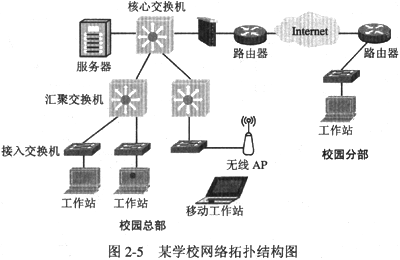【说明】
某学校欲构建校园网,根据实际情况,计划在校园总部采用有线网络和无线网络相结合的接入方式,校园分部通过Internet采用VPN技术与校园总部互联,该校园网采用了分层设计结构,其网络拓扑结构如图2-5所示。

1.【问题1】
该校园网的部分区域部署了无线网络(WLAN),采用符合IEEE 802.11g标准的无线网络设备,该校园网无线网络部分的最大数据传输速率为 (1) 。
- A.11Mb/s
- B.54Mb/s
- C.100Mb/s
- D.108Mb/s
参考答案:(2)B,或Infrastructure
解析:[要点解析]
这是一道要求读者根据实际无线局域网拓扑结构判断其工作模式的综合题。本题的解答思路如下。
无线局域网根据是否有无线接入点(AP)分为Infrastructure(基础设施网络)和Ad-Hoc(特殊网络)等两种工作模式。其中,Ad-Hoc模式是一种点对点连接,不需要无线接入点(AP)和有线网络的支持,用无线网卡连接的设备之间就可以直接通信。
基础设施网络(Infrastructure Networking)要求无线终端通过无线接入点(AP)访问骨干网上的设备,或者互相访问。无线接入点主要实现无线网络工作站与WLAN的无缝集成,对无线信号起中继放大的作用,它如同一个网桥实现在IEEE 802.11、IEEE 802.3两种标准的MAC协议之间进行转换。
由于在图2-5拓扑结构中部署了无线接入点AP设备,因此可以判断该无线局域网的工作模式是基础设施网络,即在无线AP配置中“Operating Mode(工作模式)”属性的值应选择“Infrastructure”。
